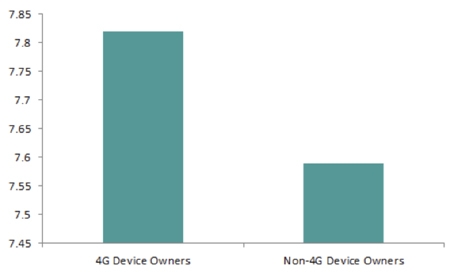OPINION17 October 2012
All MRS websites use cookies to help us improve our services. Any data collected is anonymised. If you continue using this site without accepting cookies you may experience some performance issues. Read about our cookies here.

OPINION17 October 2012
Alistair Hill, CEO of On Device Research, considers the impact that the arrival of 4G networks will have on mobile research capabilities.
The problems of 3G internet connections have been widely reported, with those wishing to stream video on their mobile often reporting a far from satisfactory user experience. The speed of the new 4G connection, however, is comparable to domestic wifi. A Guardian test of EE’s 4G network reported download and upload speeds of 38.59mps and 12.38mps respectively, compared to 3G’s 4.08mps and 2.72mps.
Experts expect 4G to create interesting patterns of behaviour as users change not only the way they consume content and purchase goods, but the environment they’re in when they do so. The knock-on effect is that it will become easier to carry out research on mobile devices and for researchers to understand the complex layers of mobile usage and how that influences purchasing.
An increase in connection speed will make it more convenient for respondents to take surveys on their mobile devices. It will allow respondents to ‘check in’ on their mobile and record their activities ‘in the moment’, which will in turn lead to more accurate and insightful results.
Surveys taken via the mobile internet will load quicker than before, meaning they can be completed in less time, resulting in more satisfied respondents, higher completion rates and ultimately better quality data for clients. Data from On Device’s mobile handset satisfaction survey in the US shows that as consumers upgrade to 4G devices they become slightly more satisfied with their device:
N=59,048 US mobile device users. On a scale of 1 to 10, please rate your satisfaction with the device you are currently using? ( 1 very unsatisfied and 10 very satisfied)
Faster connection speeds will negate the need for respondents to download a mobile survey app, as mobile surveys working in the browser will be just as usable, but with the added flexibility to work on any web-enabled device.
Wider coverage should allow researchers to connect with consumers living in rural areas that previously had very limited connectivity, while increased data capacity should bring the ability to customise client surveys to a higher quality, adding in high-res logos, images, videos and graphics. It also allows for ad testing to be completed on mobile devices.
Increased upload speeds will make it faster and easier for respondents to share pictures and video, providing a valuable resource for new and dynamic content to bring number-heavy research presentations to life.
But as the industry works to take advantage of improved mobile technology capabilities, it’s crucial that the solutions implemented are not overly complicated, at least in the early stages.
Consumers might be put off by the cost, especially in developing countries. We don’t yet know what pricing plans will be like, but if operators introduce a high cost-barrier, it will impact usage. There is also the cost of new phones: early adopters aside, the majority will wait for at least six months for 4G-enabled devices to drop in price.
Everything Everywhere will have a six month head start on its rivals when it comes to rolling out 4G. It promises the service will be available in 16 UK cities before Christmas 2012, increasing to 70% of the population by 2013. The other UK network providers will begin introducing 4G during the first half of 2013.
As the service is rolled out, it’s important researchers work with networks and device manufactures to help them understand how consumers are using the service and how satisfied they are, so further improvements can be made.
There is no doubt that an improved mobile internet infrastructure will revolutionise the research industry, as it has done in nearly every other industry. Mobile devices continue to change how the world operates, and those who embrace new technology and the opportunities it presents will be the ones to lead the industry forward to prosperity in the digital age.
3 Comments
Anon
12 years ago
That chart looks like one of the Lib Dems' "Tories can't win here" leaflets!
Like Reply Report
Dan Kvistbo
12 years ago
Good read, but surprised to find such use of a bar chart in Research Magazine. On a second note: That users that have upgraded to "4G devices" show a higher level of satisfaction with their device, doesn't necessarily have anything to do with 4G or connection speed?... In fact, it doesn't even reveal whether upgrading has made users more satisfied than they were with their former device.
Like Reply Report
John Grono
12 years ago
So that is basically a 7.8 vs a 7.6 on a 1-10 bar chart. Clearly, problem solved ... let me get my cheque book.
Like Reply Report